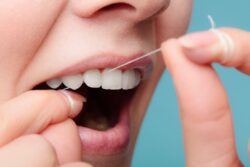Regular oral hygiene is crucial to keep your teeth and gums healthy. You know you need to brush your teeth at least twice a day and floss on a daily basis. But even if you complete this regimen when needed, you might not be getting your smile effectively cleaned if you do not floss correctly.
Cleaning between your teeth with floss will get rid of lingering plaque, food particles, and other dental dangers that could put the look and feel of your smile at risk. Remove these harmful residues as well as you can to preserve your smile’s appearance and your oral health. Read on to find advice from your dentist in Nashua, NH, that can ensure you floss your teeth properly.



How to Floss Your Teeth Correctly
Maintain a Firm Grip on Your Floss
The first step in your flossing routine involves getting a good hold of your floss. A solid grip establishes a durable foundation that will allow you to better manipulate the floss and clean it more effectively.
Take about an 18-inch string of floss and wrap each end of the string around the middle fingers of each hand. Grip the floss between your index finger and thumb of both hands to create a one-inch section of floss that you can then use to clean between your teeth. As you progress through your mouth, you will pull the string looped around your middle fingers to reveal a clean section of floss after using the previous bit.
Maneuver Floss Between Teeth with Purpose
Once you have a secure grip on your floss, you can begin the cleaning process. Insert your string gently between your teeth. Press the floss against the side of one of the teeth and rub up and down to scrub away any lingering plaque.
Shift the pressure on the tooth to make this same rubbing motion against the other tooth. Then, remove the floss from between the teeth and repeat this action for all of the teeth in your smile. Do this for both the top and bottom arches of your teeth.
Use careful movements so that you do not irritate your gums. If you notice bleeding in your gums on a regular basis, this is abnormal. Ask your dentist for a periodontal disease screening during your next dental appointment. For more information on periodontal disease and how we treat it, please see Periodontal Therapy.
Consider Alternative Flossing Tools
Dentists agree that this traditional flossing method remains an effective way to get your teeth clean and keep your smile healthy. But some patients might benefit from other flossing tools due to their unique dental circumstances.
Those who find string floss difficult to use can explore other devices that will make it easier to maintain their good oral health. Patients with orthodontic appliances can use floss picks. These are disposable tools that include a string of floss attached to a plastic handle. This can easily slide between teeth as well as dental work.
Other dental patients might want to floss with a water pick. This device generates a stream of water that will clean the teeth. People with dental implants or other fixed dental work might prefer this targeted flossing tool.
